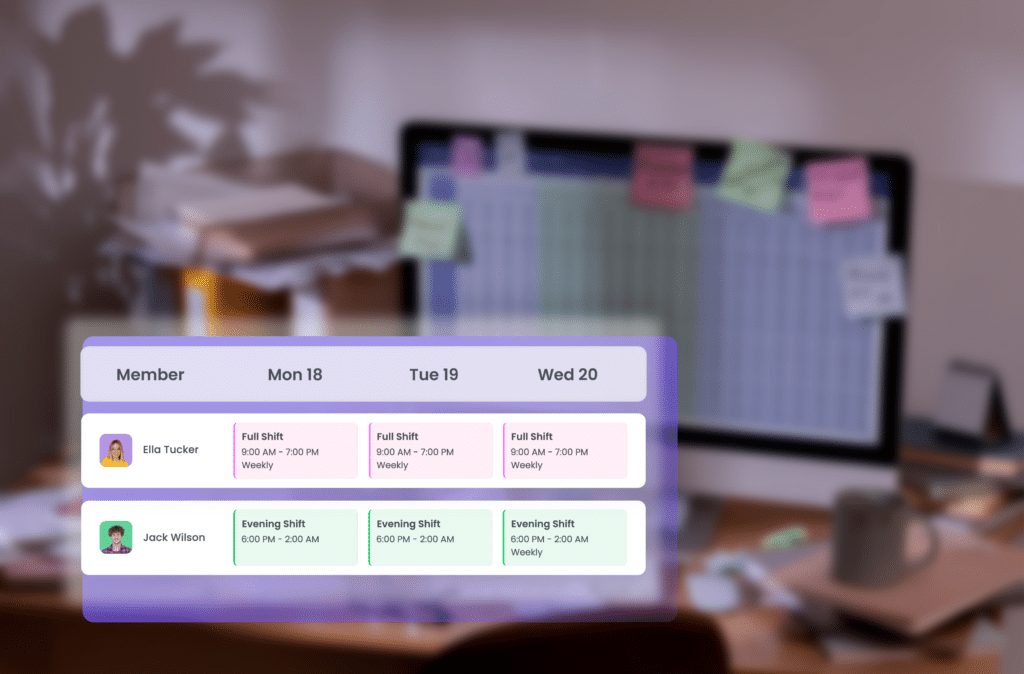Lots of businesses use employee shift schedules to operate around the clock. They can play a critical role in the success or failure of companies in many industries. If you’re looking to use staff shifts at your organization, you might wonder how to do so effectively.
In this article, we’ll dive deep into the topic of employee shift scheduling. We’ll look at how you can set it up using a time tracker, and explore key points like different shift types.
The basics of employee shift schedules
Let’s start off with the basics of the subject. An employee shift schedule allows a business to remain operational for longer than usual, typically even around the clock. They are essentially plans for how you will keep your company running at specific times of the day in the future. Employee shift schedules can even play an important role in managing time for your team. This is particularly the case when planning collaborative tasks like meetings.
To implement such schedules, you will need to take care of a few considerations. One of the most prominent of these is having enough staff available for all of your shifts. If you’re setting up employee shift schedules for the first time, you may need to hire more people.
Before committing to expanding your team, it is important to identify if shift scheduling is a good fit for your firm.
Who are employee shift schedules most suited to?
While employee shift schedules can be used for pretty much all professions, they’re most suitable for those who are in demand at all times. This includes experts in healthcare and customer support positions. Businesses that don’t need to stay open all day but benefit from longer operating hours often use shift scheduling as well. This includes brick-and-mortar firms in all sorts of industries, such as retail, hospitality, and food service.
In addition to these, companies that use traditional schedules will sometimes need to expand their operating hours too. You may want to do this at your business during a season of high demand. A typical example of this is the holiday season at the start of the year, during which people are shopping for gifts worldwide. In such cases, you should use a seasonal employee shift schedule, which we’ll cover more in-depth shortly.
Setting up an employee shift schedule with a time tracker
Now, let’s explore how you can set up an employee shift schedule using a popular productivity tool: time-tracking software.
Identify your needs
The first step to implementing anything at your business involves identifying your needs. Specifically for employee shift scheduling, you should determine how long you wish to keep your company running and when. For example, you may need to keep the lights on 24/7, or you only need a small boost in your team’s output during a peak season. Your requirements will drive lots of important decisions in your shift scheduling strategy, such as whether you’ll need to hire additional staff or not.
Assign shifts with a time tracker
After determining your goals, you can start assigning shifts. To do this with a time tracker, you will need to use a solution that offers an appropriate feature, such as WebWork’s employee shift scheduling. Simply create the shifts you want to offer to your staff and start assigning them. You can create shift schedules in lots of ways. One of the most popular practices involves assigning rotating shifts to your team, which means that staff will work varying shifts from day to day.
Review and revise periodically
After setting up your employee shift schedule, you should review its effects on your business. Doing this periodically will help you ensure that your company is benefitting from shift scheduling. If you notice any negative changes, it is important to revise your strategy early on to avoid any long-term harm to your staff and organization.

Different types of employee shifts
Employee shift scheduling can involve lots of different shift types. Let’s briefly explore a few of the most popular ones.
Day, evening, and night shifts
These three are the most common working shifts used all across the world. Their names are pretty self-explanatory, describing the timeframe they cover. There are no standardized start and end times, but day shifts typically begin at around 8:00 to 10:00. Evening shifts start at around 16:00 to 18:00, while night shifts begin at midnight or a bit later.
Weekend shifts
Weekend shifts are also quite common across various industries. As the name implies, these shifts extend staff work hours into Saturdays and Sundays. They don’t necessarily involve non-traditional schedules, such as evening or night shifts. But, these can be combined if your business requires it to achieve 24/7 operation.
Temporary shifts
Temporary shifts are pretty simple. They’re used to fulfill increased demand, typically on a seasonal basis. As mentioned previously, a common example of this happens during the holiday season at the beginning of the year. Retail businesses will be able to take advantage of this the most.
Other types of work schedules
Apart from the shifts mentioned above, your company can use a few other work schedules to achieve its productivity targets.
Flexible working hours
Flexible working schedules allow your employees to work when they want. This can help them complete their tasks when they’re the most productive throughout the day, which will vary for different people.
Part-time schedules
Hiring part-time employees can be an excellent way of boosting your company’s overall output. You can assign non-standard shifts to your part-time staff to extend your business’s operating hours quite easily.
Double shifts
The concept of double shifts is pretty simple. It involves employees working two shifts in a row, such as a day shift and an evening shift. Such schedules can help with your productivity goals as well, but they come with quite a few concerns.
Common challenges of employee shift schedules
Implementing any new strategy at your business will have its challenges. This is the case for employee shift scheduling as well, with one of the largest concerns relating to employee health.
Employee health concerns
Health concerns typically arise when staff need to work at night. This disrupts the sleep-wake cycle of the human body, otherwise known as the circadian rhythm. Apart from negatively affecting sleep, this type of shift work can harm health in other ways.
To minimize these effects, try to reduce the number of days each of your team members works at night. Moreover, you should also provide a greater degree of flexibility to your night shift workers.
Balancing preferences and needs
Balancing your company’s needs with staff preferences can be challenging. Many professionals prefer to work during the day for many reasons, one of which is the aforementioned health concerns. This will then lead to difficulties in fulfilling certain shifts, which you should plan for ahead of time. Fortunately, this shouldn’t be too challenging. Most businesses experience the highest demand for their offerings during conventional working hours. This means that a staff shortage at night shouldn’t affect your operations in most cases.
Last-minute changes
Dealing with last-minute changes is another common challenge of shift scheduling. A popular example of this is employees calling in sick, which makes backup plans vital to ensure 24/7 operation. You should always have a list of people who are willing to fill in off-duty staff at certain hours of the day.
Payroll management
If your employees work varying hours, managing payroll may be quite challenging. This is especially the case if you combine shifts with flexible working arrangements. You will need to calculate payroll hours to pay staff accurately in such cases. Fortunately, you can do so with time-tracking software as well.
The benefits of effective employee shift scheduling
Before closing off this article, let’s explore the benefits of an effective employee shift scheduling strategy.
Improved business performance
An obvious benefit of an effective employee shift schedule is increased overall performance. By remaining operational for longer, you will be able to sell more of your products. Your team will work with more customers and increase your firm’s revenue by a measurable amount.
Enhanced employee satisfaction
While this seems counterintuitive at first, some professionals may prefer non-conventional working arrangements. After all, being off work while most others are working certainly has its benefits. Enhanced satisfaction will also positively affect employee engagement, which will then provide your business with plenty of other benefits.
Closing thoughts
Employee shift schedules can play an important role in some businesses. They can allow you to stay operational 24/7 or for any other extended period. In turn, your organization will have the ability to take advantage of more opportunities, making more sales and revenue. While there are some challenges in using employee shift scheduling, its benefits make it worthwhile in the long run.

